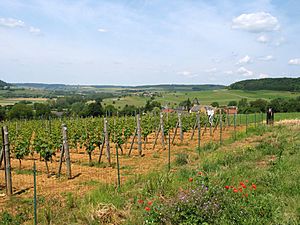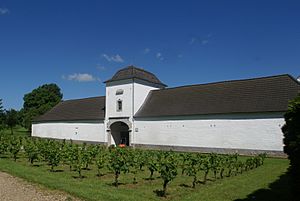Belgian wine facts for kids
Belgian wine is wine made in Belgium. Even though Belgium is not as famous for wine as countries like France or Italy, its wine production has been growing a lot in recent years. In 2004, they made about 1,400 hectoliters of wine, which is like 140,000 liters!
Contents
History of Belgian Wine
When Wine Making Started
Belgian wine first appeared a very long time ago, in the Middle Ages, around the 9th century. Before that, it's unlikely wine was made in the area we now call Belgium. The climate wasn't quite right, and the land was covered with thick forests.
However, vineyards were already growing in Paris by the 4th century. From there, vine growing slowly moved north. By the 8th century, the banks of the Rhine River were covered with vineyards. The first tries at growing grapes for wine in Belgium happened around the same time. Vineyards were already well-known in a place called Amay.
Early Vineyards and Owners
A vineyard in Vivegnis, near Liège, was already considered old in the 9th century. The same was true for a vineyard in Huy, which partly belonged to the Bishop of Liège. The areas along the Meuse River were popular for growing grapes. This was because their hillsides faced the sun, which is perfect for vines.
By the 14th century, many cities had their own vineyards. These could be inside or outside the city walls. Cities like Tournai, Louvain, Brussels, Bruges, Ghent, and Namur all had vineyards. You can still see signs of this in local place names today. For example, "Wijnberg" means "mount of vines," and "Wijngaard" means "vineyard" in Dutch.
The first people to grow vines in Belgium were often monks. They needed a clean and safe drink for their religious events. Wine was a good choice because it was safe to drink and didn't rely on collecting rainwater. So, many early vineyards belonged to abbeys. Some large abbeys even owned vineyards far from their main buildings. Important people, like the Dukes of Burgundy, also owned vineyards in places like Brussels and Louvain.
Challenges and Changes
In the 15th century, the weather became a big problem for wine growing. This was due to something called the Little Ice Age, which made the climate much colder. Some vineyards in special, warmer spots managed to survive until the 17th century.
Around the same time, people got much better at making beer. They started adding hops, which helped beer stay fresh for much longer. Beer became very popular and eventually took over from wine as the most common safe drink.
Modern Wine Growing
In the late 20th and early 21st centuries, Belgian wine growing started to grow again. This is part of a bigger trend where wine is now being made in colder places around the world. Many new vineyards in Belgium are now in areas that used to be fruit orchards.
Belgian Wine Regions
Wine is made in both Wallonia (the French-speaking part) and Flanders (the Dutch-speaking part) of Belgium. Belgium uses similar official terms for its wine regions as French wine does.
Special Wine Areas (AOCs)
Belgium has five official "Appellations d'Origine Contrôlées" (AOCs). This is a French term that means "Controlled Designation of Origin." It's a special label that shows the wine comes from a specific place and follows certain rules. Four of these AOCs are in Flanders, and one is in Wallonia.
- Hageland: This was the first AOC, created in 1997. It's in Flemish Brabant, near Leuven.
- Haspengouw: This AOC started in 2000. It's in Limburg, close to the Netherlands border. This area is home to Belgium's most famous "château" (wine castle) and largest wine producer, Wijnkasteel Genoels-Elderen.
- Heuvelland: This AOC was created in 2005.
- Flemish Sparkling Wine: There's also an AOC just for quality sparkling wine from Flanders. It's called Vlaamse mousserende kwaliteitswijn and was created in 2005.
In Dutch, these Flemish AOCs are called Hagelandse wijn, Haspengouwse wijn, and Heuvellandse wijn. The official term for AOC in Dutch is Gecontroleerde oorsprongsbenaming.
The first AOC in Wallonia is Côtes de Sambre et Meuse. It was created in 2004 and is located between the Sambre and Meuse rivers, near Liège.
Country Wines (Vin de Pays)
Belgium also has two "Vin de Pays" (country wine) regions. These cover all of Flanders and all of Wallonia.
- The Flemish country wine is simply called Vlaamse landwijn.
- The Wallonian country wine has a more fun name: Vin de pays des Jardins de Wallonie (which means "Country wine of the Gardens of Wallonia").
Types of Belgian Wine
Belgian winemakers produce different kinds of wines. However, about 90 percent of all Belgian wine is white wine. The most popular white wines are made from Chardonnay grapes. These wines are often made in a style similar to white wines from the Burgundy wine region in France.
Some Chardonnay wines are made without being aged in oak barrels. These are sometimes called "Chablis-style." Other Chardonnay wines are aged in oak barrels, which gives them a different flavor. These "Côte de Beaune-style" oak-aged wines have often been more popular with wine experts.
Grape Varieties Used
Winemakers in Belgium use many different types of grapes to make their wines. Some common white grapes include Chardonnay, Pinot blanc, and Pinot gris. For red wines, grapes like Pinot noir and Dornfelder are often used. There are also specific grapes allowed for sparkling wines, such as Pinot Meunier.
Wine Competitions
Belgium has a few wine competitions. One important one is the International Wine Contest of Monde Selection. This competition has the support of the O.I.V., which is a big international group for wine.



